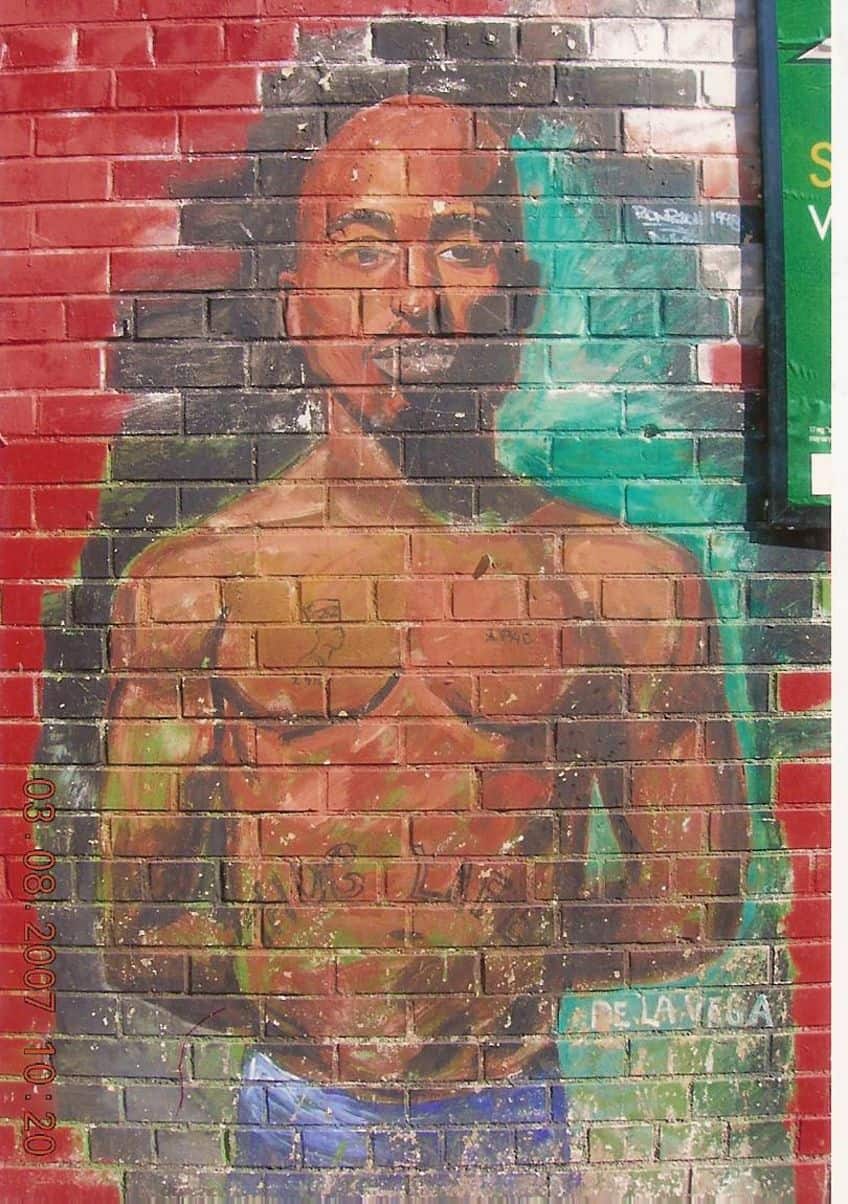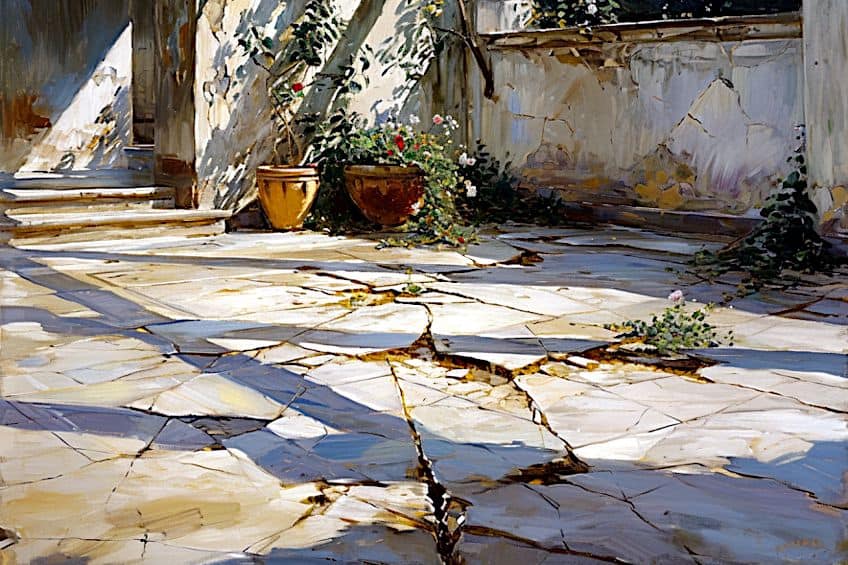“The Rose That Grew from Concrete” Analysis – A Deep Dive
Most of the poetry that we analyze here is basically very standard fare. It’s written by some poet and makes use of what you might expect from a poem. But what about an analysis of a poem written by a rapper? Today, we want to examine The Rose That Grew from Concrete meanings and interpretations by checking out this immensely famous rapper’s non-musical literary output, and we’ll do so by discussing Tupac Shakur himself, his poem, some of the themes and ideas within the poem, and the connections between this poem and his music. If an analysis of a rapper’s poetry, rather than their raps, leads to some interest in your mind, give this one a read!
The Rose That Grew from Concrete by Tupac Shakur Analysis
| Date Published | 1999 |
| Type of Poem | Free verse poem |
| Rhyme Scheme | None |
| Meter | None |
| Topic | Adversity and celebration |
We are often told that poetry is just not really a thing anymore. Poetry was this old thing that is not much enjoyed by the general populace these days unless they’re in an English class and they’re forced to sit there and listen to some ancient poem. However, this isn’t really the case. Some of the oldest poetry in existence was traditionally set to music and performed. How is that different from contemporary music with lyrics?

Lyrics are poems. They may be written with the intention of setting them to music, and elements such as a chorus are not all that common in poetry in comparison to their place in music. However, lyrics are often poetically written and presented to the audience, and the work of Tupac Shakur is no exception. In fact, many would likely argue that the work of Shakur, often better known as 2Pac, was even more poetically constructed than most of the other music that was being produced at the time (or since). This is a good point to examine, and many of the raps by 2Pac can be read as poetry if we were to read a lyric sheet. However, what about an actual poem by this famous rapper from the nineties? Well, that is why we’ll be diving into a The Rose That Grew from Concrete analysis today. Before we get to any of that though, we’re first going to stop for a moment and check out a summary of the things to come.
The Rose That Grew from Concrete Analysis Summary Points
In this The Rose That Grew from Concrete analysis, we will be looking over various elements of this poem by an acclaimed rapper, but before we do get into any of that, we are first going to see some summarized points. The reason for this is because it can often be easier to analyze something when you have some background information in mind from the very beginning:
- The Rose That Grew from Concrete is a poem about adversity and celebration. This poem comes from a very real place for the poet because they grew up in a difficult and dangerous environment. In his life, he faced adversity and violence and was able to rise above it to make something of himself. This is the ultimate meaning of the poem as it celebrates this ability to survive and even thrive despite the harsh places from which we may arise.
- The Rose That Grew from Concrete is a free verse poem. While the poem was typically known as a rapper and made comprehensive use of rhyme, this poem is instead bereft of rhyme or more traditional structures. It is also a rather short poem that would not typically manage to sustain an actual rap like the other poetically constructed raps that Shakur produced.
- The Rose That Grew from Concrete is a poem by Tupac Shakur. This figure was a rapper, actor, and activist, but he also wrote poetry. While he is best known for producing rap music under his stage name, 2Pac, he did also do a lot more. This poem shows the range of talents that he possessed as a creative. However, despite the poetry that Shakur wrote, they will likely never be seen as the things that he is notable for creating.
This summary is hardly enough to understand The Rose That Grew from Concrete meanings, themes, and so on because the only way you’ll learn all of that is by going more on a line-by-line basis.
And that is exactly what we’re going to do in this analysis, but first, let’s chat about Tupac Shakur himself for a few moments.
Biography of Tupac Shakur
| Poetic Movement | West Coast Hip Hop |
| Years | 1971 – 1996 |
| Place of Birth | New York City, United States |
| Known For |
|
Tupac Shakur is predominantly remembered as an influential American rapper, but he was also an activist, and actor. He was a major proponent of the West Coast hip-hop scene, and his work would go on to inspire many other rappers over the decades. He was also one of the best-selling musical artists of all time, and his work was often directed at an unflinching critique and portrayal of oppression, violence, racism, and so on.

He would also find success as an actor and would lay the groundwork for many other rappers who followed a similar general career trajectory. However, he did experience a variety of issues in his life. For instance, he was convicted of sexual assault and served time in prison shortly before his death. When it comes to his death, there is often still speculation about it as he was murdered in a drive-by shooting incident by an unknown assailant. Conspiracies have swirled ever since about the reasons for his murder.
However, his death at the age of 25 solidified his place as a rapper who was taken young while being one of the most influential to have ever lived.
An In-Depth The Rose That Grew from Concrete Analysis
We have now reached The Rose That Grew from Concrete analysis which was promised at the start of this article. This 2Pac text is written in free verse, and for this reason, there are no ordinary formal aspects of the poem to keep in mind as we proceed with the analysis. There is no use of rhyme or standard meter. This frees the poem up to read more like ordinary communication. In terms of the poem’s presentation here for analysis, I have arbitrarily broken it into pieces to make it easier to analyze. The poem is arranged as four different statements or questions, each of which is broken into two lines, for a total of eight lines. So, I have separated it into four different sections so that each of them can be analyzed on its own terms.

Section One
Did you hear about the rose that grew
from a crack in the concrete?
The first statement of the poem posits a question to us. This is a means of engaging with the audience by forcing them to consider the question. In this case, the question asks whether any of us have heard about the rose that has grown out of a crack in the concrete. This is a very powerful image. The opposing views of the man-made concrete can be seen as a representation of the urban environments that humans occupy against the rose, and the crack is something broken and in disrepair within that urban environment.
In this early part of the poem, we can already see that the crack is something from which adversity arises for those who are exposed to it.
Those who grow up in these “cracks” are the ones who need to have perseverance to be able to make it at all. Because out of it, something like a rose can have the means to grow. A rose is a potent image that has so many symbolic attachments. For instance, we can see the rose as something beautiful that arose from the cracks and managed to survive, but despite its beauty, it is surrounded by thorns to protect itself.

Section Two
Proving nature’s law is wrong it
learned to walk with out having feet.
The second statement in the poem tells us that the supposed laws of nature are wrong. This rose that arose out of the crack in the ground was never meant to rise. The oppressive nature of the urban environments that 2Pac often wrote and rapped about, which affected African Americans above all others, are oppressive places that do not foster growth. It goes against the supposed “laws of nature” that such places produce for something beautiful to ever be able to escape its clutches. We can see the hope embedded within this beauty and joy.
Perseverance has paid off for this rose as it grew in the most inhospitable of places.

Section Three
Funny it seems, but by keeping its dreams,
it learned to breathe fresh air.
The second-last stanza opens by pointing out the seeming absurdity of the rose ever being able to grow out of such a place, but there is where the poem shifts to a focus on dreams. The rose, which metaphorically represents Tupac Shakur and, by extension, others who might have risen out of the same kind of oppressive situations, was only able to grow because it had dreams that it refused to give up on. Those who managed to escape are suggested, by the poem, to only get out of those places because they had hope and perseverance.
It was able to learn to breathe the air that was freer than anything they’d experienced before.

Section Four
Long live the rose that grew from concrete
when no one else ever cared.
The final statement of the poem is our final point of wrapping up the text as a whole. It tells the rose that it must live as long as it is able to live. It grew out of the worst kind of place it could have grown from, but it survived, and it has continued to survive in such a place. The final line is a darker and more unpleasant one because while the rose may have survived and thrived by breaking through the concrete, no one had ever cared about it.
So, the speaker wants it to live and hopes that it will despite no one really caring as he does.

The Rose That Grew from Concrete Meanings and Themes
In my The Rose That Grew from Concrete analysis, I looked at various themes for this poem, but as a more definitive wrap-up, let’s discuss them a little more here. The poem examines, through the use of metaphor, a person who is forced to live through adversity and must fight to rise above the odds and come out on top. This view of oppression is integral to an understanding of the poem.
However, out of that sense of oppression and misery, there is the chance for growth despite the difficulties in doing so.
The poem becomes a piece of celebration. It wants us to strive to be better in our lives regardless of any of the hardships that we might face. The world is often a cruel and tough place, but the poem valorizes those who are strong enough to continue to follow their dreams through perseverance and self-assertiveness.
The Relation Between The Rose That Grew from Concrete and Other Tupac Shakur Songs and Poems
One of the things that anyone familiar with the work of Tupac Shakur will probably realize immediately is that The Rose That Grew from Concrete shares very similar themes with the music for which he was predominantly known. His work often focused on social issues, such as systemic racism in African American communities and the dangers of life in gang territory cities.

This poem, like many of the raps that Shakur wrote, is concerned with resilience and perseverance in the face of these difficulties. Much of his music would share many commonalities with this poem. While many of his raps are aggressive, in keeping with gangsta rap tradition, he does also have many raps, and poems, that show a more sensitive disposition. This The Rose That Grew from Concrete analysis should have shown part of that more sensitive side that wanted to express feelings of hope in what is often a hopeless world for many.
Today, we have examined a text that is a little different from the usual poetry we discuss here. Music is a fascinating thing because lyrics are basically poems that are set to instruments, but we don’t often think of it that way. Many of the raps by Tupac Shakur are highly poetic in their structure, presentation, and content, yet many may not agree. However, when it comes to my The Rose That Grew from Concrete analysis, we can see that rappers such as these are also capable of writing more standard poetry that is not intended to be set to music at all. Regardless of this, there is poetry throughout the music of 2Pac, so if you want to experience more of that, give some of it a listen!
Frequently Asked Questions
What Is The Rose That Grew from Concrete by Tupac Shakur?
The Rose That Grew from Concrete is a poem by Tupac Shakur, often better known by his stage name, 2Pac. This poem is an examination and exploration of personal growth and resolve. The poem comes from a dark place in which Shakur metaphorically recounts the way in which he was forced to grow up in an oppressive environment. It is a celebration of overcoming adversity and developing as a person despite the difficulties faced in life. It is a poem about self-love and self-respect.
Who Was Tupac Shakur?
Tupac Shakur was an American rapper who was best known under the stage name, 2Pac. He would go on to become one of the most influential figures in hip hop and was a major figure in West Coast hip hop in the nineties. He grew up in and around gang culture, and much of this existence would lead to the later raps that he produced. He was ultimately shot and killed when he was only 25 years old in a drive-by shooting incident.
What Type of Poem Is The Rose That Grew from Concrete?
In my The Rose That Grew from Concrete analysis, we saw that this text is a free verse poem. This means that it doesn’t adhere to the standard rules of poetry that one might ordinarily expect. For instance, there is no use of rhyme or consistent meter. Instead, it makes use of a very informal presentation and basic vocabulary. The simplicity of the words and structure contribute to the straightforward nature of the message that is being presented to the reader.
What Are the Themes of The Rose That Grew from Concrete?
The basic idea behind The Rose That Grew from Concrete is that it is about growing up in a difficult situation and still managing to not only survive, but also to thrive. The poem examines oppression, and how one can pull themselves out of situations in which the odds are not in their favor. The poem is about overcoming diversity through willpower and the desire to grow and improve as a person.
How Does The Rose That Grew from Concrete Relate to Other Tupac Shakur Poems and Songs?
When it comes to a The Rose That Grew from Concrete analysis, it is easy to see how it relates to other works by Tupac Shakur, provided you are familiar with his work. His music was often related to the dangers of growing up in gang territory, the oppression felt by African American people, the pervasive role of violence in society, and so on. However, many of his poems are also about persevering despite that, and The Rose That Grew from Concrete falls into this category like many of 2Pac’s raps.
Justin van Huyssteen is a freelance writer, novelist, and academic originally from Cape Town, South Africa. At present, he has a bachelor’s degree in English and literary theory and an honor’s degree in literary theory. He is currently working towards his master’s degree in literary theory with a focus on animal studies, critical theory, and semiotics within literature. As a novelist and freelancer, he often writes under the pen name L.C. Lupus.
Justin’s preferred literary movements include modern and postmodern literature with literary fiction and genre fiction like sci-fi, post-apocalyptic, and horror being of particular interest. His academia extends to his interest in prose and narratology. He enjoys analyzing a variety of mediums through a literary lens, such as graphic novels, film, and video games.
Justin is working for artincontext.org as an author and content writer since 2022. He is responsible for all blog posts about architecture, literature and poetry.
Learn more about Justin van Huyssteen and the Art in Context Team.
Cite this Article
Justin, van Huyssteen, ““The Rose That Grew from Concrete” Analysis – A Deep Dive.” Art in Context. February 3, 2024. URL: https://artincontext.org/the-rose-that-grew-from-concrete-analysis/
van Huyssteen, J. (2024, 3 February). “The Rose That Grew from Concrete” Analysis – A Deep Dive. Art in Context. https://artincontext.org/the-rose-that-grew-from-concrete-analysis/
van Huyssteen, Justin. ““The Rose That Grew from Concrete” Analysis – A Deep Dive.” Art in Context, February 3, 2024. https://artincontext.org/the-rose-that-grew-from-concrete-analysis/.









